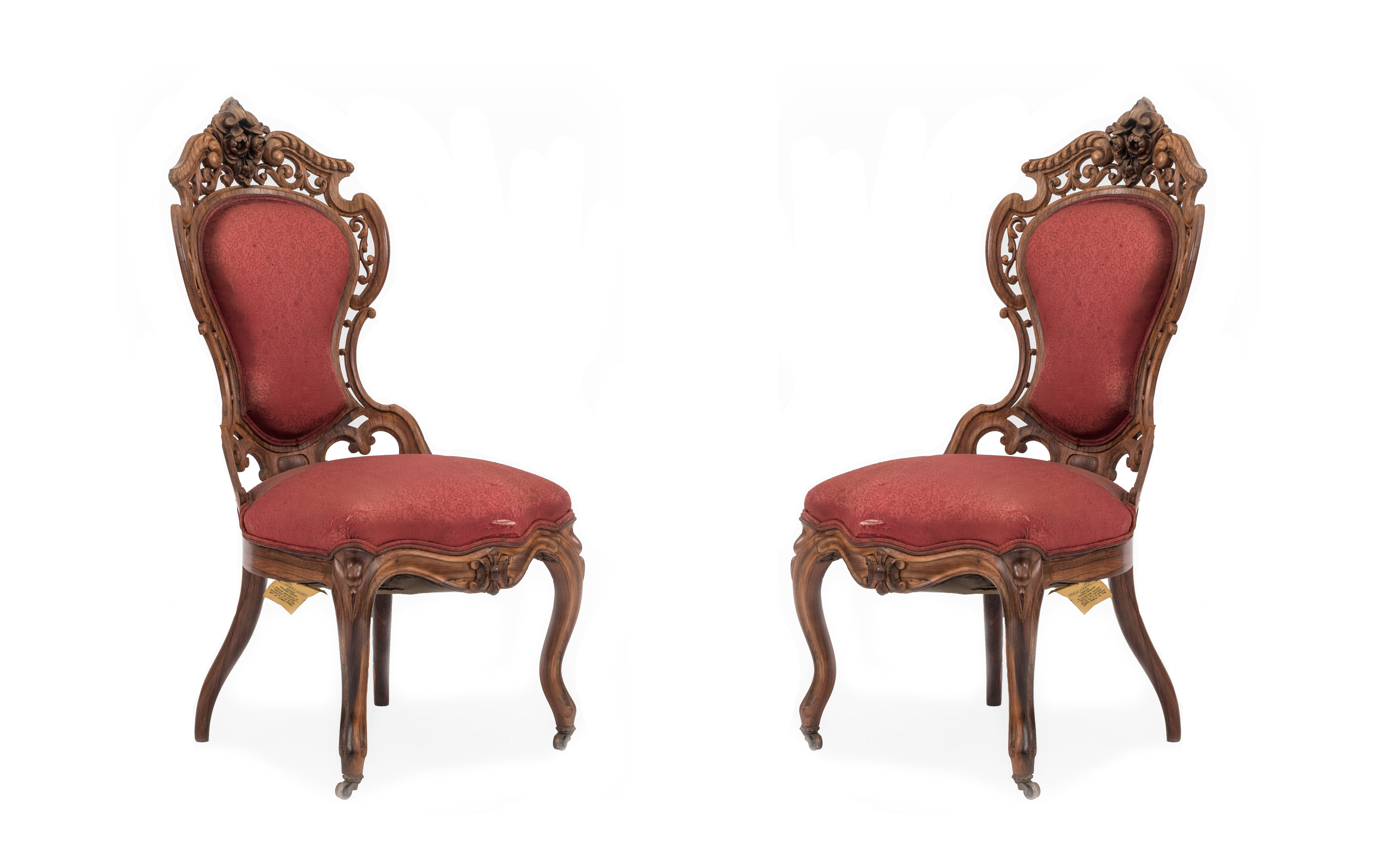X
{{ modalTitle }}
PLEASE FILL IN THE REQUIRED FIELDS.X
X
{{ modalTitle }}
Choose one of the options below.X
ITEM SUCCESSFULLY
ADDED TO PROJECT
Pair of American Victorian Red Damask Side Chairs
 American
American Victorian
Victorian Seating
Seating Side Chairs
Side Chairs
Newel Warehouse
32-00 Skillman Ave
Long Island City NY - 11101
 (212) 758-1970
(212) 758-1970
Pair of American Victorian Red Damask Side Chairs

Newel Warehouse
32-00 Skillman Ave
Long Island City NY - 11101
 (212) 758-1970
(212) 758-1970
 Seating
Seating Side Chairs
Side Chairs
About Joseph Meeks & Sons
Joseph Meeks & Sons was a prominent American furniture manufacturing company that operated during the 19th century. The company was founded by Joseph Meeks in New York City in 1829 and went on to become one of the most successful and influential furniture makers of its time.
Joseph Meeks, born in 1790, began his career as a cabinetmaker and quickly gained a reputation for his read more..
Victorian
Period in English furniture during the reign of Queen Victoria 1837-1901. Consists of a resurrection of many previous periods and revival imitations including: Gothic, Tudor, Elizabethan, Rococo, and Neoclassic style. This period had a focus on dark woods, heavy fabrics, embellishment, engagement with newly developed imitation materials that were facilitated by the Industrial Revolution, and a tendency towards eclecticism.
Filigree
Primarily refers to fine, ornate metalwork (mainly in gold, silver, or copper), that is intricately patterned and used as ornamentation or embellishment, particularly in fine jewelry making. More broadly, the term can refer to any ornamental openwork that is delicate or fine that resembles a metal filigree in its pattern, but in other mediums.
Rosewood
A close-grain tropical hardwood with a distinct, floral scent. It is typically a dark red color with occasional violet and black variegations. It is prized for both fine furniture and instrument-making.
Damask
A linen, cotton, rayon, or silk fabric with a reversible jacquard weave. Damasks are woven on a jacquard loom using predominantly monotone fibers and a combination of weaving techniques most commonly satin and twill variants creating a tone on tone pattern that is produced by the contrast of matte and reflective surfaces. Prior to the invention of the jacquard loom in the early 1800s, damasks were woven by hand and considered a luxury fabric, but the loom's ability to produce bulk yardage allowed for more widespread access to damask fabrics within middle-class households in the 19th Century.
Victorian
Period in English furniture during the reign of Queen Victoria 1837-1901. Consists of a resurrection of many previous periods and revival imitations including: Gothic, Tudor, Elizabethan, Rococo, and Neoclassic style. This period had a focus on dark woods, heavy fabrics, embellishment, engagement with newly developed imitation materials that were facilitated by the Industrial Revolution, and a tendency towards eclecticism.
Filigree
Primarily refers to fine, ornate metalwork (mainly in gold, silver, or copper), that is intricately patterned and used as ornamentation or embellishment, particularly in fine jewelry making. More broadly, the term can refer to any ornamental openwork that is delicate or fine that resembles a metal filigree in its pattern, but in other mediums.
Rosewood
A close-grain tropical hardwood with a distinct, floral scent. It is typically a dark red color with occasional violet and black variegations. It is prized for both fine furniture and instrument-making.
Damask
A linen, cotton, rayon, or silk fabric with a reversible jacquard weave. Damasks are woven on a jacquard loom using predominantly monotone fibers and a combination of weaving techniques most commonly satin and twill variants creating a tone on tone pattern that is produced by the contrast of matte and reflective surfaces. Prior to the invention of the jacquard loom in the early 1800s, damasks were woven by hand and considered a luxury fabric, but the loom's ability to produce bulk yardage allowed for more widespread access to damask fabrics within middle-class households in the 19th Century.
Victorian
Period in English furniture during the reign of Queen Victoria 1837-1901. Consists of a resurrection of many previous periods and revival imitations including: Gothic, Tudor, Elizabethan, Rococo, and Neoclassic style. This period had a focus on dark woods, heavy fabrics, embellishment, engagement with newly developed imitation materials that were facilitated by the Industrial Revolution, and a tendency towards eclecticism.
Filigree
Primarily refers to fine, ornate metalwork (mainly in gold, silver, or copper), that is intricately patterned and used as ornamentation or embellishment, particularly in fine jewelry making. More broadly, the term can refer to any ornamental openwork that is delicate or fine that resembles a metal filigree in its pattern, but in other mediums.
Rosewood
A close-grain tropical hardwood with a distinct, floral scent. It is typically a dark red color with occasional violet and black variegations. It is prized for both fine furniture and instrument-making.
Damask
A linen, cotton, rayon, or silk fabric with a reversible jacquard weave. Damasks are woven on a jacquard loom using predominantly monotone fibers and a combination of weaving techniques most commonly satin and twill variants creating a tone on tone pattern that is produced by the contrast of matte and reflective surfaces. Prior to the invention of the jacquard loom in the early 1800s, damasks were woven by hand and considered a luxury fabric, but the loom's ability to produce bulk yardage allowed for more widespread access to damask fabrics within middle-class households in the 19th Century.













